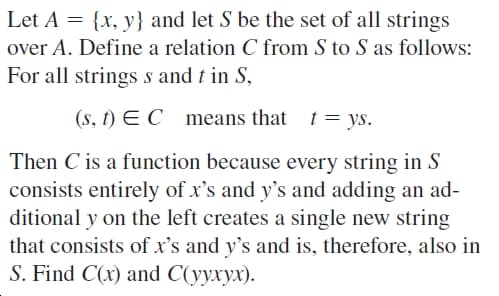Let A = {x, y} and let S be the set of all strings over A. Define a relation C from S to S as follows: For all strings s and t in S, (s, t) E C means that t= ys. Then C is a function because every string in S consists entirely of x's and y's and adding an ad- ditional y on the left creates a single new string that consists of x's and y's and is, therefore, also in S. Find C(x) and C(yyxyx).
Let A = {x, y} and let S be the set of all strings over A. Define a relation C from S to S as follows: For all strings s and t in S, (s, t) E C means that t= ys. Then C is a function because every string in S consists entirely of x's and y's and adding an ad- ditional y on the left creates a single new string that consists of x's and y's and is, therefore, also in S. Find C(x) and C(yyxyx).
Elements Of Modern Algebra
8th Edition
ISBN:9781285463230
Author:Gilbert, Linda, Jimmie
Publisher:Gilbert, Linda, Jimmie
Chapter1: Fundamentals
Section1.2: Mappings
Problem 10E: For each of the following parts, give an example of a mapping from E to E that satisfies the given...
Related questions
Question

Transcribed Image Text:Let A = {x, y} and let S be the set of all strings
over A. Define a relation C from S to S as follows:
For all strings s and t in S,
(s, t) E C means that t= ys.
Then C is a function because every string in S
consists entirely of x's and y's and adding an ad-
ditional y on the left creates a single new string
that consists of x's and y's and is, therefore, also in
S. Find C(x) and C(yyxyx).
Expert Solution
This question has been solved!
Explore an expertly crafted, step-by-step solution for a thorough understanding of key concepts.
This is a popular solution!
Trending now
This is a popular solution!
Step by step
Solved in 2 steps with 2 images

Recommended textbooks for you

Elements Of Modern Algebra
Algebra
ISBN:
9781285463230
Author:
Gilbert, Linda, Jimmie
Publisher:
Cengage Learning,

Elements Of Modern Algebra
Algebra
ISBN:
9781285463230
Author:
Gilbert, Linda, Jimmie
Publisher:
Cengage Learning,